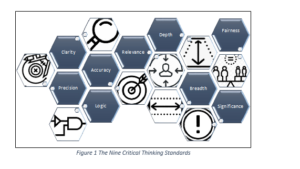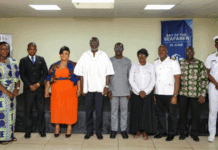- Critical thinking for problem-solving
We began last week with an overview of the problem-solving process, looking at the two hemispheres of the problem-solving continuum and how we need a strategic combination of a good methodology, a set of tools and techniques, and the activation of certain thinking typologies to solve problems holistically.
This approach necessitates individuals and teams solving problems to wear a variety of thinking hats throughout the process. In today’s issue, I’ll be discussing the first on this list of thinking typologies: Critical Thinking.
The underlying premise of this write-up is captured in Paul and Elder’s manifesto on critical thinking (Critical Thinking: Intellectual Standards Essential to Reasoning Well Within Every Domain of Human Thought, Journal of Developmental Education, 2013). They assert that:
“Critical thinking is self-guided, self-disciplined thinking which attempts to reason at the highest level of quality in a fair-minded way. People who think critically consistently attempt to live rationally, reasonably, and empathically… They use the intellectual tools that critical thinking offers – concepts and principles that enable them to analyse, assess, and improve thinking…”
The nine standards of critical thinking
Critical thinkers embody the Socratic principle: “The unexamined life is not worth living” because they realise that many unexamined lives together result in an uncritical, unjust, dangerous world. The consequences of uncritical thinking are all too visible in organisational leaders’ interventions to solve their problems: band-aid solutions for deep wounds, workarounds that we never get back to re-working around, and half-baked solutions.
Critical thinking problem-solving teams and leaders are those who weigh problems from multiple perspectives and assert the clarity, accuracy, precision, logic, and significance of their argument and thinking perspectives. They argue from a place of relevance by assessing issues in depth within the confines of the conversation’s breadth, while asserting that the conclusions they reach and the solutions they devise are fair to all parties involved. And with this, I set in motion a lovely segue into the nine critical thinking standards (Fig 1)
 Let us explore how we apply these standards to problem-solving:
Let us explore how we apply these standards to problem-solving:
i. Clarity. To what extent is my point easily understood by myself and others?
Clarity is the entry point, and rightly so. Clarity is determined by how well we define the problem we are attempting to solve. Remember the old adage: ‘a well-defined problem is a problem half-solved’. A problem statement that is not well-focused does not answer as many questions as a well-focused statement. As they seek to transition their definitions from broad and vague to narrow and granular, problem-solving teams must investigate the use of tools such as project charters and apply the 6W’s and H.
ii. To what extent is my information at hand true or correct without distortion?
Problem-solving teams must investigate various methods to ensure that the data and information used to define and analyse problems are free of errors, mistakes, or distortions: are they true and correct? Accuracy is synonymous with correctness. How data is obtained and stored in databases – the appropriate sampling schemes, sampling strategies, data collection methods, coding, data cleansing, and so on – are all ways to ensure data accuracy.
iii. To what extent is my information exact and specific to the necessary level of detail?
A statement can be both clear and accurate while lacking precision. What level of detail do we require in relation to the data or information required for analysis? Precision is concerned with specificity. How many decimal points does our data need to be to avoid losing detail when we round off? What tools will we need to collect the data? Teams must keep in mind that data obtained through measurement (continuous or variable data) is always richer than discrete data (categorical/contextual or count data). For example, stating rainfall based on the number of days it has rained is not as informative as stating how many millimetres of rain we have received during the same period. The level of detail required will necessitate the development and deployment of appropriate tools and measurement systems.
iv. To what extent does my information and input relate to the issue at hand?
This is one standard that problem-solving teams miss most of the time. Relevance implies a close logical relationship with, and importance to, the matter under consideration. A statement can be clear, accurate, and precise but not relevant to the question at issue. Project teams are frequently found looking in the wrong places in their quest for understanding of the issue at hand. It is useful to assume individuals have not fully assessed thinking except to the extent that they have considered all issues, concepts, and information relevant to it.
v. To what extent am I conversant with the complexities of the issues?
This standard refers to thoroughness in considering all of the variables in a situation, context, idea, or question. The understanding of a team can be clear, accurate, precise, and relevant, but it can also be superficial (i.e., lack depth). Depth answers the question of whether the team is dealing with the complexities inherent in the problem at hand. Many problems have multiple variables. And even if not all, variables are significant, teams should thoroughly understand the variables under study so that as they progress through the analysis, they can narrow down from the trivial many to the critical few.
vi. To what extent am I considering the issue at hand within the necessary contexts and relationships?
Problem-solving teams must approach the task from multiple angles, be comprehensive in scope, broad in scope, and broad in outlook. Variables in a problem are frequently linked. The breadth standard will reveal which factors are significant in and of themselves to changes in the y variable (main effects) and which factors interacting with other factors are significant to what we are observing – the outcome, output, or response variable.
vii. To what extent do my conclusions follow from the evidence?
This standard implies the parts make sense together. There is a logic to everything – even the most outlandish of phenomena; and dare I say, even to chaos. Problem solvers, whether in soliciting information from stakeholders or seeking to understand the reasoning behind why people do what they do or why things are the way they are, must start off on the premise that validates how the parts make sense together, with no contradictions in keeping with the principles of sound judgment and reasonability. The team must establish logical validity to underpin the phenomena they are studying. When the combination of thoughts is mutually supporting and makes sense in combination, the thinking is logical. When the combination is not mutually supporting, it is contradictory or does not make sense, the combination is not logical.
viii. To what extent can I identify and focus on the most important aspects of the issue at hand?
This implies importance or consequence – having weighty or substantial meaning. What does this have to do with problem-solving? First and foremost, is this the most pressing problem that we must address to meet strategic objectives? Are the areas of the business where we are looking to for answers the most important? Are the people we’re talking to the most important people? Thinking can be significant or insignificant. It can focus on what is most substantive, important, and has the most significant implications, or it can focus on the trivial and superficial.
ix. To what extent am I able to avoid privileging my own biases?
Fairness means being free from bias, dishonesty, favouritism, selfish interest, deception, or injustice. Humans naturally think from a personal perspective, from a viewpoint that favours their position. A corollary to Murphy’s Law goes: no good deed goes unpunished; perhaps, a very good reason to develop consequential metrics when curating improvement projects and designing solutions – which is our conscience preventing us from making our solutions become problems in other parts of the business. Fairness entails treating all relevant viewpoints equally without regard for one’s own feelings or interests. Because everyone tends to be biased in favour of their own viewpoint, it is important to keep the intellectual standard of fairness at the forefront of thinking.
Conclusion: Practising and systematising critical thinking in the problem-solving process
Muscles get stronger with use. The same can be said of the critical thinking muscle. Every skill is enhanced through practice. Every practice is perfected through exertion. Critical thinking is a skill; so fortunately, it can be learned, enhanced through practice, and systematised through the problem-solving process. A phrase that runs through each of the standards as I elaborated is “to what extent…”. Ultimately, one’s critical intellectualism resides in the extent to which one applies these standards.
Now comes the seamless integration of critical thinking standards with problem-solving tools and techniques. The problem solver’s arsenal contains a plethora of tools. Which tools do we employ, and when do we employ them? The wisdom is that the requirements of the standard under consideration must serve as a trigger for determining which tool to deploy. For example, I use a project charter to establish clarity; an interrelationship digraph to answer the question of depth; a measurement system to establish data accuracy and precision; and the stating of consequential metrics to establish fairness.










